Foot and Ankle Surgery

Foot and Ankle Surgery
BUNIONS
HAMMERTOES
NEUROMAS
NEW RADIOSURGERY
Find out more about our Foot and Ankle Surgery, specialties, products, treatment options and more in our Glossary.
Sometimes conservative treatment just won’t solve your foot problem. Foot and Ankle Surgery can be your best option. You want to make sure that your Pittsburgh Podiatry surgeon is board certified and has performed the surgery you need many times. All of the surgeons at Beaver Valley Foot Clinic are board certified and highly trained to treat all of your foot problems.
You don’t have to battle the Pittsburgh traffic to find the most highly skilled foot and ankle surgeons available for Podiatry in Pittsburgh.
Only a surgically trained podiatrist does enough foot surgeries on a regular basis to maintain foot specific skills. Since we are specialist and only care for the foot and ankle, you are receiving care from the most highly trained skilled doctor available for you problem.
We keep Current on the Latest Foot and Ankle Surgery
We take over 50 continuing education credits biannually to bring you the most up to date surgical techniques available.
Dr. Teimouri DPM has two goals with regard to your successful treatment. The first is to put an end to your foot pain now and for good. The second is to do everything possible to relieve your fears about treatment. Unlike a lot of the “quick fix” types of medical care today,She takes the time necessary to really know you, as a patient, as a person, and as a partner in your recovery. That’s why you’ll always get one-on-one care from her personally. She will always listen attentively to your concerns, your ideas, and your fears. She’ll put you at ease with a complete explanation of your diagnosis, then discuss how it should be treated in easy to understand terms.
If you have been putting off that procedure for years, come on in and talk to Dr Teimouri DPM . See if this is right for you. Dr T is happy to answer all of your questions about the procedure. Our Board certified Podiatrist will discuss expected time off work. She will explain the amount of pain involved, both during and after surgery. Dr Teimouri will offer nonsurgical alternatives. After that, if you do not want to proceed with surgery, then that’s ok too. At least you know.
Foot and Ankle Surgery this Board Certified surgeon sees every day.
BUNION Foot and Ankle Surgery
Bunions are an enlargement of the tissue and bone around the joint on the side of the foot. They are often caused by genetics, but can also occur from tight shoes or injury. Symptoms include redness, inflammation, swelling and discomfort.
Tailor’s Bunion or Bunionette
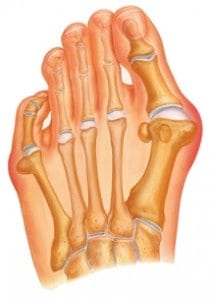
A bone that sticks out, like a swelling or a lump on the outside of the foot, behind the fifth (pinky) toe, the “small bunion” or bunionette is caused by a variety of conditions including trauma, heredity or faulty biomechanics (the way someone walks), to name a few.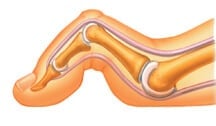
HAMMERTOE Foot and Ankle Surgery
Symptoms of Hammertoes – curled or bent toes- include calluses, blisters, ulcerations, corns, redness and pain. Correction is simple, and performed right in the office surgical suite, no hospital at all. You will have a few stitches and elevate your foot for a few
days. Most people who fix their hammertoes say if they would have known how simple it was they would’ve done it years ago!
NEUROMA Foot and Ankle Surgery
A Neuroma is irritation of the nerve sheath, found between the 3rd and 4th toes. A Neuroma can be irritated by high-heels, trauma, arthritis or an abnormal bone structure.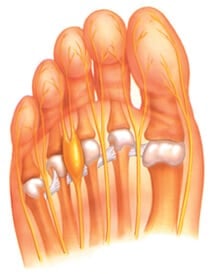
Neuroma Symptoms
Do you feel “a rolled up sock feeling” in the ball of the foot? Do you have tingling or burning sensations around the ball of the foot? You can get relief from taking your shoes off, stopping running/walking and rubbing the area. It can feel like having a rock in your shoe. Prior to surgery, cortisone injections often help to shrink the nerve making it less irritated. Then arch supports can help keep the bones from moving abnormally and not irritating the Mortons Neuroma.
NEW Radiosurgery and Lasers in Podiatry – Keeping One Step Ahead !
Beaver Valley Foot Clinic- Bringing the latest technology to help our patients achieve the best results with less discomfort,
Introducing…RADIOSURGERY.
Radiosurgery is the newest, most effective way to remove unwanted tissue. It easily treats ingrown nails. If you’ve dug out ingrown nails yourself, or suffer through repeat doctor visits we can help. There is now a quick, rapidly healing and safer way to remove them in our office.
A wave of electrons at radiofrequency (bands between AM and FM) is used to remove the abnormal corner of the nail. The electrode remains ‘cold’ during the procedure, so the remaining tissue is protected from any burns. Compared to ‘cutting the root out’, or chemically burning the root with acid, or burning it with a ‘hot laser’, the healing time is cut in half or less! The radiowaves also keep the tip sterile, reducing the incidence of post-op infections, making this the perfect procedure for diabetic patients.
Plantar Warts and small tumors are better removed with Radiosurgery.
When making surgical incisions for procedures like hammertoes, Radiosurgery vaporizes approximately one layer of cells on either side of the incision giving the thinnest scar possible. This podiatric office can also answer questions about laser surgery, posterior tibial tendon dysfunction, fallen arches and brace supports.
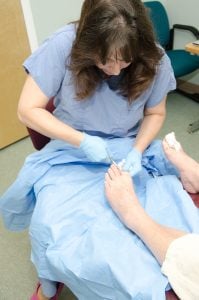
So call with any questions about various lumps and bumps, or cysts and tumors. Your feet aren’t supposed to hurt. Call Beaver Valley Foot Clinic today at 878-313-FEET (3338) !
Bunions & Hammertoes
Bunions
A bunion is an enlarged bone on the side of the big toe that angles outwardly. Depending on the severity of the bunion, the big toe may angle mildly or sharply toward the other toes. If wider shoes aren’t giving you the relief you need a simple outpatient procedure can have you back into your shoes in 3 to 6 weeks.
Hammertoes
A hammertoe is an arched toe, the result of an abnormal contraction or “buckling” that leaves the toe in a claw-like position. Once stiffened into position, hammertoes rub against shoes and cause painful corns and calluses. A simple 15 minute office procedure will permanently fix this problem.


Foot Surgery
Ankle Sprains
Ankle Sprains are caused by sudden sideways motion, a twist, or a misstep. When your foot lands off balance, muscles may give way, allowing the ankle joint to move too far. If ligaments connecting the foot and anklebones overstretch or tear, a sprain is the result. These sudden injuries cause pain both at the time they occur and throughout the healing process. Depending on the sprain, swelling and bruising may extend from your ankle into your foot. With proper care, however, sprains will heal correctly. And, in many cases, you can reduce the risk of reinjury.
“We Even Treat Little Feet”
Does your daughter complain of pain in her foot? Does your son avoid gym class or other activities because of the pain he feels in his heel? It is unusual for children to complain of foot pain, so if they do mention it, there is most likely a problem behind it. Often, the problem is a case of flat feet. If you or your spouse has flat feet, it is likely that your child does too, as the condition is hereditary.
A child may complain of pain on the inside or outside of the ankle or the bottom of the foot. Older child may develop painful bunions (a bump on the side of the big toe) or hammertoes (curling or crooked toes) as a result of flat feet. If your child does have a painful flat foot, the doctors at the Beaver Valley Foot Clinic can assess the problem and decided on a proper course of treatment.
Flat Feet
Most flat feet will require simple orthotic inserts in your child’s shoe to help realign the foot. If that does not alleviate the pain, we can surgically correctthe foot to prevent further problems down the road. Due to the latest surgical techniques, simple surgery can now correct the flat foot. This requires minimal recovery time. Please keep in mind that the doctors explore a full course of conservative treatment prior to the performance of any surgical procedure.
Heel Pain
Another common foot problem in children is heel pain. This usually occurs in active children between ages 8 and 12 who spend a lot of time running around, playing sports or dancing. These children often will complain of pain in the back of the heel that worsens during or immediately after physical activity. The technical tern for this condition is Calcaneal Apophysitis or Seaver’s disease. We often refer to it as “growing pains.”
Achilles Tendon
In the back of the heel bone, where the Achilles’ tendon attaches to the bone, there is a growth plate that enables the bone to continue to grow as the child ages. For some children in this age group, the bone grows faster than the muscles and the tendons of the leg. This causes the Achilles’ tendon to become to tight and to pull on the back of the heel bone. Fortunately, the treatment for this condition is always conservative and does not require surgery. Stretching, icing, anti-inflammatory medicines, heel lifts and a temporary decrease in activity usually relieves the pain. The good news is that the growth plate closes over time, so the pain does not reoccur and no long-term problems result from this condition. For adults, the noninvasive ESWT, Extracorporeal Shockwave Therapy is available to treat your heel pain in one 20 minute visit.
Are there any restrictions on driving or other activities following foot and ankle surgery?
Yes, there are typically restrictions on driving and certain activities following foot and ankle surgery. The specific restrictions depend on the type of surgery and the individual’s recovery progress, but they often include:
- Driving: Patients are generally advised not to drive for a certain period after foot and ankle surgery, especially if the surgery was on the right foot and involves the use of the driving foot.
- Weight-bearing: Restrictions on weight-bearing activities may be in place, requiring the use of crutches, a walker, or a wheelchair for mobility.
- Physical activity: Strenuous physical activities, such as running, jumping, or heavy lifting, are usually restricted for a period to allow for proper healing.
- Work: Depending on the type of work and the demands it places on the feet and ankles, patients may need to take time off or modify their work duties during recovery.
How can patients prepare their home environment for optimal recovery after foot and ankle surgery?
Patients can prepare their home environment for optimal recovery after foot and ankle surgery by following these tips:
- Arrange for assistance: Arrange for someone to help with daily tasks, such as cooking, cleaning, and running errands, especially during the initial recovery period.
- Create a comfortable space: Set up a comfortable and accessible space where the patient can rest and elevate their foot, such as a recliner or a bed with plenty of pillows.
- Stock up on supplies: Stock up on supplies such as groceries, medications, and toiletries before surgery to avoid the need for frequent trips outside the home.
- Modify the home layout: Remove obstacles and create clear pathways to move around safely with crutches, a walker, or a wheelchair if needed.
Ingrown toenails, warts …
Other common pediatric foot problems to be aware of include ingrown toenails and warts. The Beaver Valley Foot Clinic can treat most pediatric foot conditions. The doctor has 5 children of the own, ans she is sympathetic to young patients as well as parents. she has dedicated herself to provide gentle yet comprehensive foot care for patients of all ages.
Chronic Ankle Sprains: a cycle of pain and instability.
The skeleton is made up of bones, yet the ligaments ultimately bind them together into a functional whole. These vital support structures are short, leathery connective tissue bands. They form tight, bag like joint capsules, and cross each joint like stout, flat cables. Their primary function is resisting the enormous forces the muscles exert upon the bones as they contract. The final result is the body in motion.
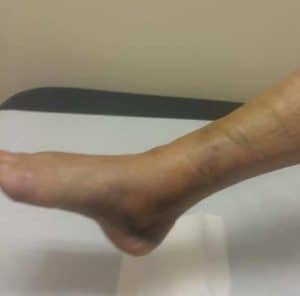
Ligaments are extremely robust yet have their limits. They have a poor blood supply as well, largely due to their rope-like nature. This unfortunately means that when injured they often don’t heal fully or completely. A vicious cycle of partial healing, increasing pain and dysfunction, and re-injury can result.
The ankle joint is perhaps the best example of this, and chronic ankle pain and instability is extremely common. Both ankles share the weight of the body, and are uniquely susceptible to twisting and “rolling” injuries. This stretches out or even tears the joint capsule and associated ligaments, often leading to chronic re-injury.
Medical science has an effective, minimally invasive solution though, right? The answer may depend on who you ask. Surgical interventions have a miserable track record of successfully resolving chronic ankle instability. We can suture a torn ligament with some degree of success. Any stretching which occurs during a sprain, however, can be much harder to deal with. A large body of research reflects this. It finds surgery no more effective than physical therapy.
